- Home
- Garden Wildlife
- Insects
- Hymenoptera
- Solitary bees
Above left: Neat semicircular holes removed from false acacia by a leaf-cutter bee, right: leaf-cutter bee nest in decaying wood, lined with the circles of leaf. Below left: Nest of the Red mason bee in a hollow stem showing the yellow food store and mud cap. Below right: close-up of a Red mason bee egg on the pollen and nectar "cake" in its cell.
Some solitary bee species behave like cuckoos. They do not make nests of their own but go into the nest of another bee species and lay their eggs there. These kleptoparasitic cuckoo bees do not add to the food store in the nest, so the cuckoo bee larvae take the food intended for the larvae of the host bee. Coelioxys species lay eggs in the nests of Megachile and Anthophora species; Nomada species, which have a wasp-like appearance, lay eggs in the nests of ground-nesting bees, such as Lasioglossum and Andrena species; Sphecodes species lay eggs in the nests of Andrena, Lasioglossum and Halictus species, Stelis species lay eggs in the nests of Anthidium, Osmia, Hoplitis and Heriades species; Epeolus species lay eggs in nests of Colletes species; Melecta species in the nests of Anthophora species.
Life cycle
Male solitary bees generally emerge a few days before the females and fly around in search of females to mate with. The males are relatively short-lived and play no part in nest construction or provisioning the nest with food for the larvae. Once the female has selected a suitable nest site, she sets about creating and provisioning the cells in which the larvae will develop.
Solitary bees differ from honeybees and bumblebees in the way in which they provide food for their larvae. Social bees feed their larvae in open cells throughout their development period with a nutritious liquid diet supplied by the worker bees. Solitary bees stock their cells with a paste made of pollen and nectar. When enough food has been stored in a cell, the female lays a single egg on the food store and seals the cell. The mother bee has no further contact with her larvae, which feed themselves on their pellets of stored food. The mother bee does not live long enough to see her offspring emerge.
When fully fed, the larvae pupate within their cells. Most solitary bees have one generation a year but some have a spring and summer brood. Most solitary bees overwinter as pupae in the nests and emerge as adult bees in spring or summer.
Role of solitary bees in gardens
Solitary bees are of great value as pollinating insects. They are more tolerant of cold conditions than honeybees, so can be significant pollinators of fruit trees in cold or wet springs. Solitary bees that nest in ready-made tunnels can be encouraged in gardens by drilling holes in fence posts or providing bundles of hollow plant stems. The diameter of the holes should be in the range of 2-8mm. Garden centres sell a range of solitary bee nest sites. The more successful types consist of a bundle of cardboard tubes with a diameter of about 7mm. These are readily used by the red mason bee in spring and by leaf-cutting bees later in the summer. Solitary bee nest sites should be placed in sunny positions.
Some Andrena species like to nest in short turf, such as lawns. They sometimes cause consternation on warm sunny days in spring when large numbers of males are flying around and females are beginning to excavate new nests, creating a mini-volcano of soil above each nest entrance. Male bees lack ovipositers and cannot sting at all. Female solitary bees have stings but they are not at all aggressive and so there is no risk to children or pets. The nest building periods only lasts for a few weeks, so any nuisance caused by these bees soon stops.
Leaf-cutting bees remove pieces of leaf from various plants, especially roses, when the females are constructing their nests. Each cell is made up of 20 or more pieces of leaf and a nest can contain 10-20 cells. A female leaf-cutting bee often returns to the same plant when she needs more nest building material, so a favoured plant may have some depleted foliage by the time the nest is complete. Leaf-cutting bees are active in mid-late summer, so the leaf loss does not have a big impact on plant growth.
Other sources of information
Websites
Website of the Bees, Wasps and Ants Recording Society (BWARS)
Images and information by Steve Falk
Solitary Bees in your Garden. Excellent download from Marc Carlton's website
Hymettus. Several illustrated information sheets on various solitary bee species
Books
Benton, T. (2017) Solitary Bees. Naturalists Handbooks 33. Pelagic Publishing (highly recommended)
Kirk, W. D. J. & Howes, F. N. (2012) Plants for Bees. International Bee Research Association especially Chapter 4: Plants for solitary bees by Christopher O'Toole
Wilmer, P. (1985). Bees, Ants and Wasps – A key to the genera of British Aculeates. A Field Studies Council AIDGAP key
Falk, S and Lewington, R. 2015 Field Guide to the Bees of Great Britain and Ireland. Field Studies Council AIDGAP key
By Andrew Halstead reviewed by Andrew Salisbury edited by Steve Head
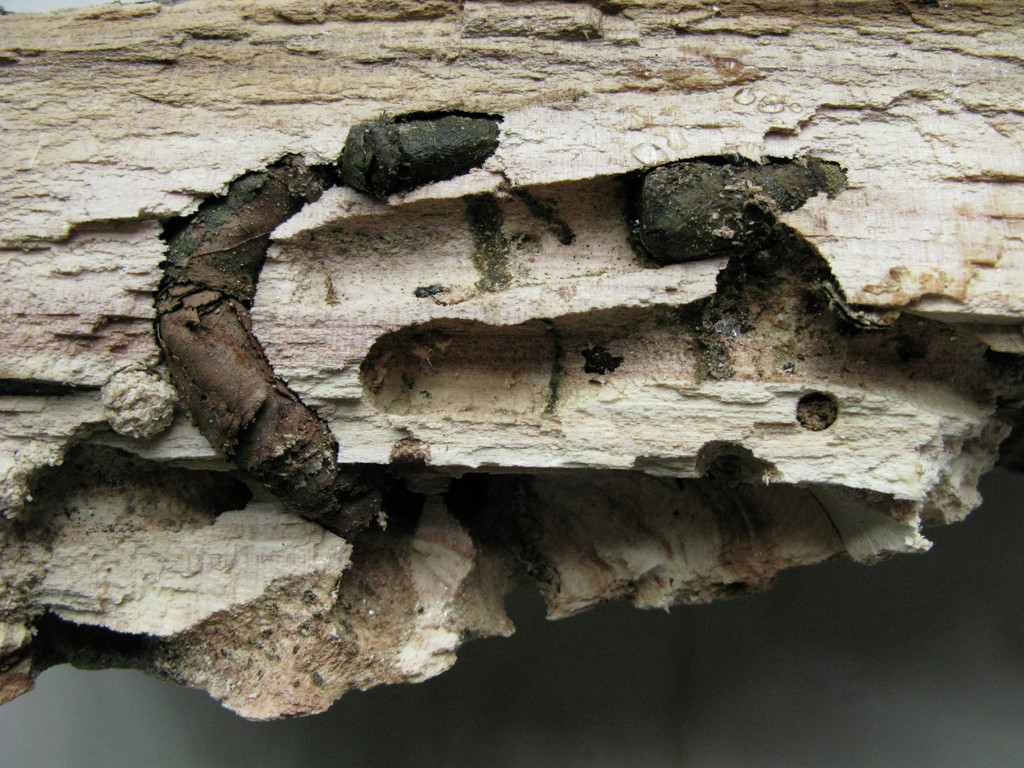
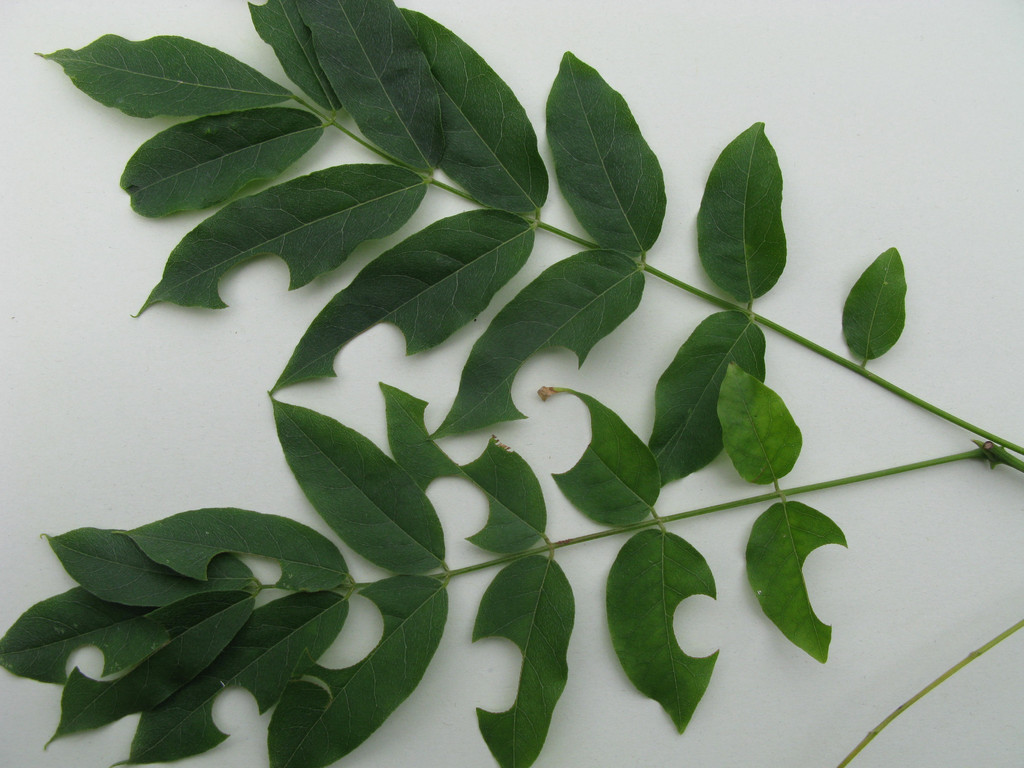
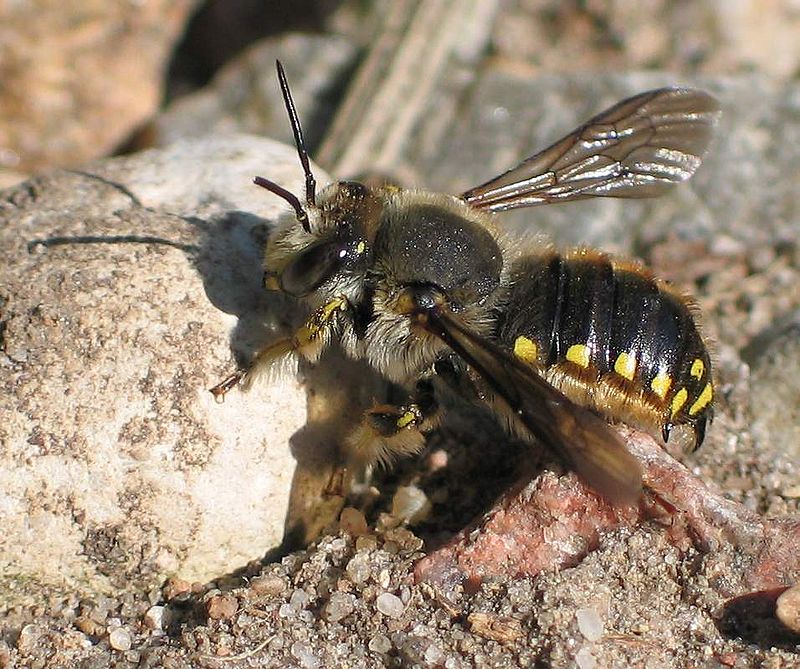
Solitary bees
Solitary bees are solitary in the sense that each female constructs and provisions her own nest. There is no worker caste, as in social bees, such as bumblebees and the honey bee. Solitary bee nests can, however, occur in large numbers in closer proximity to each other. Jennifer Owen found 45 species of solitary bee in her garden study from five families, with the burrowing Andrena species the most common. Because they have no massive communal food store to defend, female solitary bees have only mild stings which they are reluctant to use unless roughly handled. Some have common names related to their nesting habits, such as Mason, Mining, Carpenter, Leaf-cutter and Wool carder bees. Note that the other Carder bees are social bumblebees, not soiltary species.
Species in Britain and Ireland
There are 236 species of solitary bee recorded in Britain and Ireland. Some are rare or restricted to particular habitats but others are common and will nest and forage in gardens. These include species of Andrena, Lasioglossum, Halictus, Osmia, Megachile, Anthophora, Colletes and Anthidium genera.
Anthidium manicatum is commonly known as the wool-carder bee because of its habit of collecting hairs from plants to make the cells in its nest. The foliage of lamb’s ears, Stachys byzantina, is frequently used and male Wool-carders can often be seen patrolling above this plant, waiting for females to appear.
The ivy bee, Colletes hederae, is a recent arrival in Britain, being first found in Dorset in 2001, and it is spreading northwards in England and Wales. It is active in the autumn and it collects nectar and pollen from ivy flowers. Megachile species, such as Megachile centuncularis, Megachile ligniseca and Megachile willughbiella, are commonly known as leaf-cutting bees. The hairy-footed flower bee, Anthophora plumipes, is an early spring bee that resembles a small bumblebee.
Above left: Wool-carder bee Anthidium manicatum Centre: Ivy bee Colletes hederae right: Hairy-footed flower bee Anthophora plumipes.
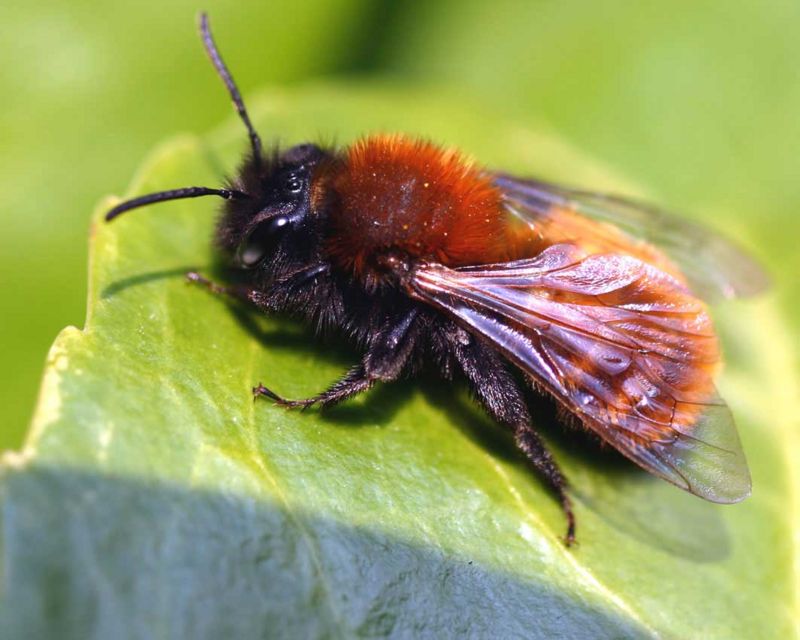
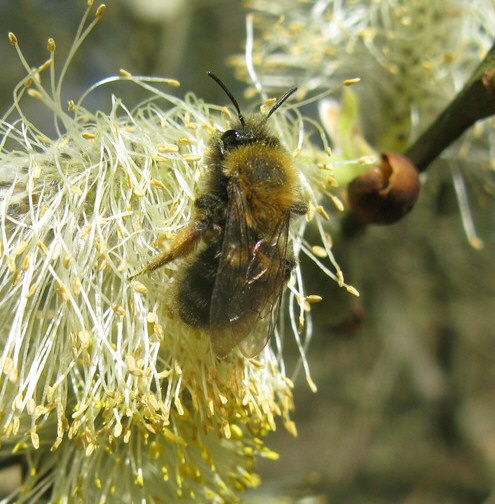
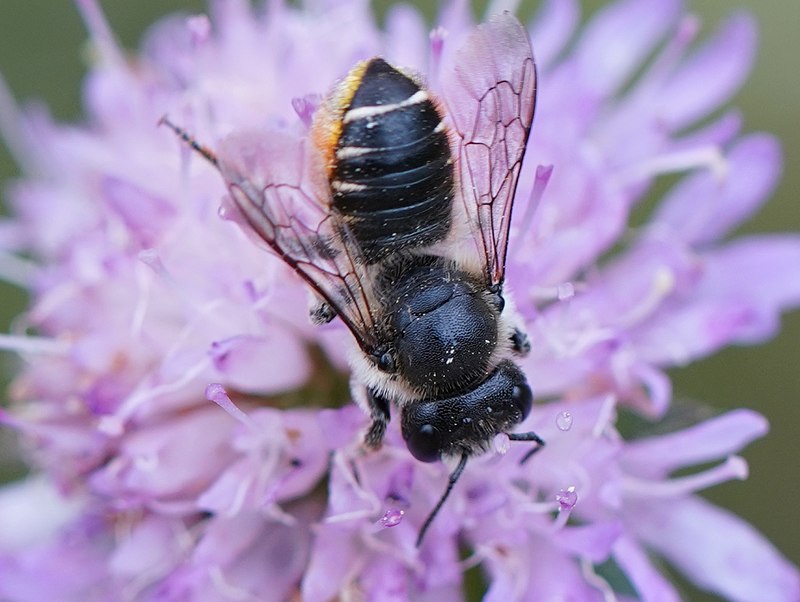
.jpg)
Above left: Pair of Red mason bees, Osmia bicornis (formerly O.rufa), centre: Colletes daviesanus, very common in Jennifer Owen's garden, right: Lasioglossum morio.
.jpg)
.jpg)
Above left: Andrena fulva, the commonest solitary bee recorded by Jennifer Owen, centre: Andrena clarkella on a willow catkin, right: A leaf-cutter bee, Megachile centuncularis
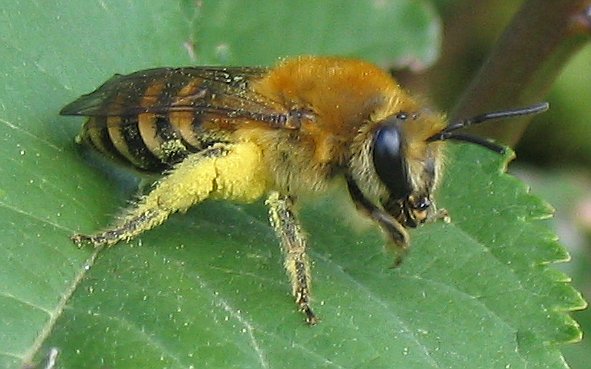
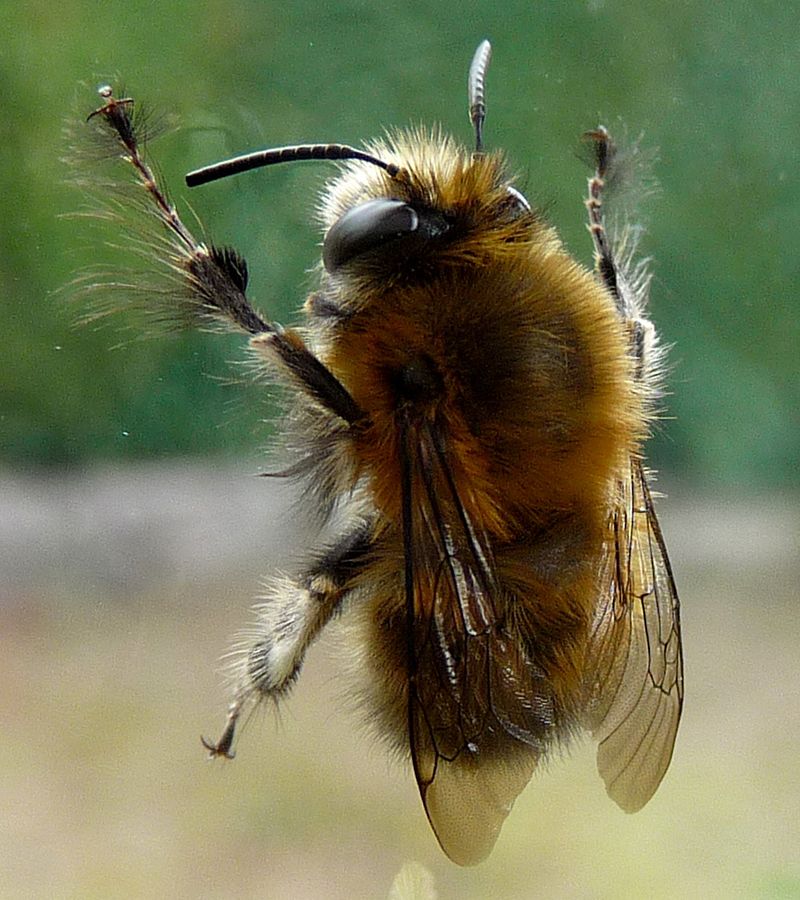
Biology
Pollen provides proteins and fats in a bee’s diet, in addition to the sugars contained in nectar. Most bees carry pollen loads back to their nests on their hind legs, which are modified for this purpose. Osmia and Megachile species, however, carry pollen in the hairs on the underside of their abdomens. Some solitary bees are very specific when it comes to which flowers they will visit. One of the mining bees, Andrena florea, only takes pollen from the flowers of white bryony, while Andrena praecox is only interested in pollen from various willow species. Most solitary bees will collect pollen from a much wider range of flowers.
Solitary bees make their nests in a variety of situations. Mining bees, such as Andrena, Lasioglossum, Halictus, Anthophora and Colletes species usually make their nests in the soil. The female makes a tunnel down into the soil or into the vertical face of an earth bank. The tunnel has a number of side chambers or cells where the female will store a paste of nectar and pollen as food for the larvae.
Above left: aggregation of solitary mining bee nests on a footpath - probably Andrena sp. Above right, Ivy bee Colletes hederae on the earth pile excavated from its nest hole.
Megachile, Anthidium and some Osmia species will nest in hollow plant stems or will make nest tunnels in rotten wood. Megachile species cut leaf portions from various plants and use them to construct the cells in which the larvae will develop. The red mason bee, Osmia bicornis collects mud to create its larval cells, while other Osmia species make their cells from chewed up leaves. A tiny solitary bee, Chelostoma campanularum makes its nests in dead wood, using the holes made by woodworm beetle larvae.
![Photo: Ian Alexander [CC BY-SA 4.0 (https://creativecommons.org/licenses/by-sa/4.0)]](images/Ivy_Bee_Colletes_hederae_GT.jpg)
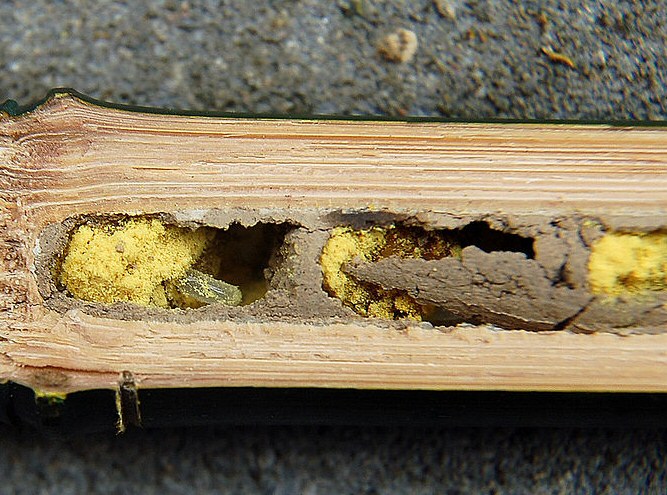
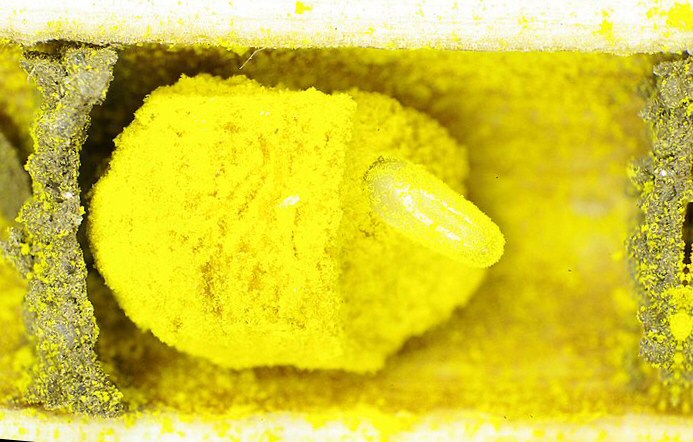
Solitary bees
Solitary bees are solitary in the sense that each female constructs and provisions her own nest. There is no worker caste, as in social bees, such as bumblebees and the honey bee. Solitary bee nests can, however, occur in large numbers in closer proximity to each other. Jennifer Owen found 45 species of solitary bee in her garden study from five families, with the burrowing Andrena species the most common. Because they have no massive communal food store to defend, female solitary bees have only mild stings which they are reluctant to use unless roughly handled. Some have common names related to their nesting habits, such as Mason, Mining, Carpenter, Leaf-cutter and Wool carder bees. Note that the other Carder bees are social bumblebees, not soiltary species.
Species in Britain and Ireland
There are 236 species of solitary bee recorded in Britain and Ireland. Some are rare or restricted to particular habitats but others are common and will nest and forage in gardens. These include species of Andrena, Lasioglossum, Halictus, Osmia, Megachile, Anthophora, Colletes and Anthidium genera.



Above left: Andrena fulva, the commonest solitary bee recorded by Jennifer Owen, above right: Andrena clarkella on a willow catkin
Left: A leaf-cutter bee, Megachile centuncularis
Above left: Pair of Red mason bees, Osmia bicornis (formerly O.rufa), above right: Colletes daviesanus, very common in Jennifer Owen's garden.
Left: Lasioglossum morio.
.jpg)
.jpg)
.jpg)



Anthidium manicatum is commonly known as the wool-carder bee because of its habit of collecting hairs from plants to make the cells in its nest. The foliage of lamb’s ears, Stachys byzantina, is frequently used and male Wool-carders can often be seen patrolling above this plant, waiting for females to appear.
The ivy bee, Colletes hederae, is a recent arrival in Britain, being first found in Dorset in 2001, and it is spreading northwards in England and Wales. It is active in the autumn and it collects nectar and pollen from ivy flowers. Megachile species, such as Megachile centuncularis, Megachile ligniseca and Megachile willughbiella, are commonly known as leaf-cutting bees. The hairy-footed flower bee, Anthophora plumipes, is an early spring bee that resembles a small bumblebee.
Above left: Wool-carder bee Anthidium manicatum Above right: Hairy-footed flower bee Anthophora plumipes.
Below: Ivy bee Colletes hederae
![Photo: Ian Alexander [CC BY-SA 4.0 (https://creativecommons.org/licenses/by-sa/4.0)]](images/Ivy_Bee_Colletes_hederae_GT.jpg)


Above left: aggregation of solitary mining bee nests on a footpath - probably Andrena sp. Above right, Ivy bee Colletes hederae on the earth pile excavated from its nest hole.
Megachile, Anthidium and some Osmia species will nest in hollow plant stems or will make nest tunnels in rotten wood. Megachile species cut leaf portions from various plants and use them to construct the cells in which the larvae will develop. The red mason bee, Osmia bicornis collects mud to create its larval cells, while other Osmia species make their cells from chewed up leaves. A tiny solitary bee, Chelostoma campanularum makes its nests in dead wood, using the holes made by woodworm beetle larvae.


Above left: Neat semicircular holes removed from false acacia by a leaf-cutter bee, right: leaf-cutter bee nest in decaying wood, lined with the circles of leaf. Below left: Nest of the Red mason bee in a hollow stem showing the yellow food store and mud cap. Below right: close-up of a Red mason bee egg on the pollen and nectar "cake" in its cell.
Some solitary bee species behave like cuckoos. They do not make nests of their own but go into the nest of another bee species and lay their eggs there. These kleptoparasitic cuckoo bees do not add to the food store in the nest, so the cuckoo bee larvae take the food intended for the larvae of the host bee. Coelioxys species lay eggs in the nests of Megachile and Anthophora species; Nomada species, which have a wasp-like appearance, lay eggs in the nests of ground-nesting bees, such as Lasioglossum and Andrena species; Sphecodes species lay eggs in the nests of Andrena, Lasioglossum and Halictus species, Stelis species lay eggs in the nests of Anthidium, Osmia, Hoplitis and Heriades species; Epeolus species lay eggs in nests of Colletes species; Melecta species in the nests of Anthophora species.
Life cycle
Male solitary bees generally emerge a few days before the females and fly around in search of females to mate with. The males are relatively short-lived and play no part in nest construction or provisioning the nest with food for the larvae. Once the female has selected a suitable nest site, she sets about creating and provisioning the cells in which the larvae will develop.
Solitary bees differ from honeybees and bumblebees in the way in which they provide food for their larvae. Social bees feed their larvae in open cells throughout their development period with a nutritious liquid diet supplied by the worker bees. Solitary bees stock their cells with a paste made of pollen and nectar. When enough food has been stored in a cell, the female lays a single egg on the food store and seals the cell. The mother bee has no further contact with her larvae, which feed themselves on their pellets of stored food. The mother bee does not live long enough to see her offspring emerge.
When fully fed, the larvae pupate within their cells. Most solitary bees have one generation a year but some have a spring and summer brood. Most solitary bees overwinter as pupae in the nests and emerge as adult bees in spring or summer.
Role of solitary bees in gardens
Solitary bees are of great value as pollinating insects. They are more tolerant of cold conditions than honeybees, so can be significant pollinators of fruit trees in cold or wet springs. Solitary bees that nest in ready-made tunnels can be encouraged in gardens by drilling holes in fence posts or providing bundles of hollow plant stems. The diameter of the holes should be in the range of 2-8mm. Garden centres sell a range of solitary bee nest sites. The more successful types consist of a bundle of cardboard tubes with a diameter of about 7mm. These are readily used by the red mason bee in spring and by leaf-cutting bees later in the summer. Solitary bee nest sites should be placed in sunny positions.
Some Andrena species like to nest in short turf, such as lawns. They sometimes cause consternation on warm sunny days in spring when large numbers of males are flying around and females are beginning to excavate new nests, creating a mini-volcano of soil above each nest entrance. Male bees lack ovipositers and cannot sting at all. Female solitary bees have stings but they are not at all aggressive and so there is no risk to children or pets. The nest building periods only lasts for a few weeks, so any nuisance caused by these bees soon stops.
Leaf-cutting bees remove pieces of leaf from various plants, especially roses, when the females are constructing their nests. Each cell is made up of 20 or more pieces of leaf and a nest can contain 10-20 cells. A female leaf-cutting bee often returns to the same plant when she needs more nest building material, so a favoured plant may have some depleted foliage by the time the nest is complete. Leaf-cutting bees are active in mid-late summer, so the leaf loss does not have a big impact on plant growth.
Other sources of information
Websites
Images and information by Steve Falk
Hymettus. Several illustrated information sheets on various solitary bee species
Books
Benton, T. (2017) Solitary Bees. Naturalists Handbooks 33. Pelagic Publishing (highly recommended)
Kirk, W. D. J. & Howes, F. N. (2012) Plants for Bees. International Bee Research Association especially Chapter 4: Plants for solitary bees by Christopher O'Toole
Wilmer, P. (1985). Bees, Ants and Wasps – A key to the genera of British Aculeates.
Falk, S and Lewington, R. 2015 Field Guide to the Bees of Great Britain and Ireland. Field Studies Council AIDGAP key
By Andrew Halstead reviewed by Andrew Salisbury edited by Steve Head
Biology
Pollen provides proteins and fats in a bee’s diet, in addition to the sugars contained in nectar. Most bees carry pollen loads back to their nests on their hind legs, which are modified for this purpose. Osmia and Megachile species, however, carry pollen in the hairs on the underside of their abdomens. Some solitary bees are very specific when it comes to which flowers they will visit. One of the mining bees, Andrena florea, only takes pollen from the flowers of white bryony, while Andrena praecox is only interested in pollen from various willow species. Most solitary bees will collect pollen from a much wider range of flowers.
Solitary bees make their nests in a variety of situations. Mining bees, such as Andrena, Lasioglossum, Halictus, Anthophora and Colletes species usually make their nests in the soil. The female makes a tunnel down into the soil or into the vertical face of an earth bank. The tunnel has a number of side chambers or cells where the female will store a paste of nectar and pollen as food for the larvae.













